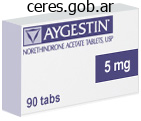
General Information about Aygestin
In conclusion, Aygestin is a medicine that's used to treat sure menstrual and uterine issues. It works by regulating the menstrual cycle, managing heavy bleeding, and reducing symptoms of endometriosis. It is important to comply with the prescribed dosage and to discuss any potential dangers along with your physician before starting this medication. With correct use, Aygestin can provide relief and enhance the quality of life for women with these circumstances.
In uncommon cases, Aygestin may improve the chance of blood clots, particularly in girls who smoke, are over the age of 35, or have a history of blood clots. Therefore, you will want to talk about any potential risk elements with your doctor earlier than beginning Aygestin.
Aygestin, also known as norethindrone, is a medicine used for the remedy of sure menstrual and uterine problems. These circumstances could cause disruptions in a woman’s day by day life and general health, and Aygestin offers relief by regulating the menstrual cycle and managing abnormal bleeding.
Aygestin is out there in pill form and is often taken once a day, with or with out food. It is essential to take the medication on the same time every day to maintain consistent levels in the body. It is also important to follow the dosage prescribed by your physician and to not miss any doses.
It is necessary to tell your doctor of another medications you're taking earlier than starting Aygestin. This contains over-the-counter medications, nutritional vitamins, and natural supplements. Some drugs may interact with Aygestin and affect its effectiveness.
In ladies with endometriosis, Aygestin works by suppressing the growth of the endometrial tissue, which can trigger painful intervals and infertility. It also reduces the inflammation and swelling related to endometriosis, offering reduction from signs similar to pelvic ache and discomfort.
Abnormal bleeding is often a results of hormonal imbalances or underlying medical circumstances corresponding to fibroids or endometriosis. Aygestin works by mimicking the hormone progesterone in the body, which helps to steadiness out the degrees of estrogen and progesterone. This helps to regulate the menstrual cycle and reduce heavy bleeding.
In addition, Aygestin should not be utilized by pregnant women as it might hurt the unborn baby. It can be not recommended to be used whereas breastfeeding, as small quantities of the medication may pass into breast milk.
As with any medication, there are potential side effects associated with Aygestin. These may embody nausea, headache, breast tenderness, and adjustments in menstrual bleeding patterns. If any of those side effects persist or turn into bothersome, it is essential to consult with your doctor.
Aside from its use in managing menstrual and uterine issues, Aygestin can be used for other situations as determined by a health care provider. These might include treating irregular bleeding attributable to hormonal imbalances, stopping pregnancy, or managing signs of premenstrual syndrome (PMS).
Apical membrane uptake of substances occurs via endocytosis and other transport pathways (Fanos and Cataldi, 2001; Nagai and Takano, 2004; Orbach et al. Following endocytosis of aminoglycosides, which involves megalin, the endocytic receptor for cationic ligands, these drugs are translocated into the lysosomal compartment. These drugs accumulate and subsequently form myeloid bodies, which are membrane fragments and damaged organelles formed as a consequence of aminoglycoside inhibition of lysosomal enzymes (Cummings and Schnellmann, 2001; Kaloyanides et al. This apical pathway of uptake leads to accumulation of a critical aminoglycoside concentration within cells, triggering an injury cascade that causes cell injury and death. Basolateral delivery of drugs that are either organic anions or cations by peritubular capillaries is another pathway by which proximal tubular cell toxin exposure occurs (Enomoto and Endou, 2005; Ciarimboli et al. Once within the cells, drugs traverse the intracellular space via various regulated carrier proteins, and subsequently exit from the cells via apical transport proteins (Ciarimboli et al. It is this extensive trafficking of drugs through the cells that increases renal tubular exposure and risk for elevated concentration of toxin when other risk factors supervene. Prolonged therapy with high doses of a nephrotoxic agent enhances kidney injury based on excessive renal exposure, even in the absence of other risk factors. Aminoglycosides with more positive charge are more likely to cause nephrotoxicity, perhaps due to enhanced interactions with negatively charged membrane phospholipids and megalin (Rougier et al.
Aygestin Dosage and Price
Aygestin 5mg
- 30 pills - $27.54
- 60 pills - $46.37
- 90 pills - $65.19
- 120 pills - $84.02
- 180 pills - $121.68
- 270 pills - $178.16
- 360 pills - $234.64
